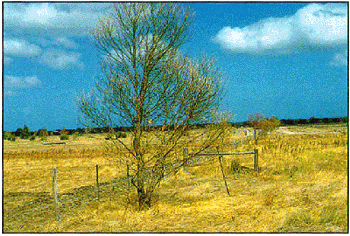Economic significance
Wingless grasshoppers are summer pests that cause most damage when eating green feed in the late nymphal and adult stages. The peak of grasshopper activity does not coincide with the growth of annual pasture and hoppers eat only small amounts of dry matter. At a density of 30 adults per square metre, only about 10% of annual pasture in an affected area is eaten by grasshoppers. This is not enough to significantly affect stock carrying capacity. In contrast with this, the loss of perennial pasture can be very significant.
Clover germinating in summer on south coastal areas is particularly susceptible to grasshoppers until May, and grasshoppers have been known to severely damage irrigated crops and pastures, dryland lucerne, and tagasaste plantations.
Damage to native trees is common and repeated defoliation may kill mature trees (see Figures 3 and 4). The economic significance of this 'tree decline' is not known. Newly-planted trees are especially susceptible and it is unlikely than any species can survive heavy infestations without strategic grasshopper control. Some species (for example, Tasmanian blue gum, Eucalyptus globulus) appear to possess some tolerance, probably through their unpalatability to wingless grasshoppers.
Years with unusually high summer/autumn rainfall (as was the case in 1990) allow the development of more feed which results in increased wingless grasshopper populations in the following summer.


